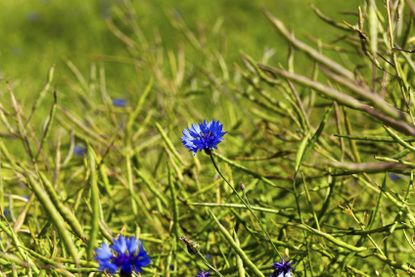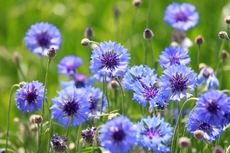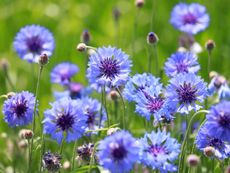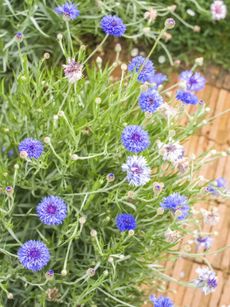Yellow Leaves On Bachelor’s Button – Why Do Plant Leaves Turn Yellow


Bachelor’s buttons are generally carefree plants with a capacity to delight that far exceeds the effort they require. That's why gardeners are surprised when something goes wrong with these summer garden staples. Find out what to do when your bachelor’s button leaves are turning yellow in this article.
Why Do Plant Leaves Turn Yellow?
Bachelor’s button plants seldom have trouble with insects or disease, so what can cause the leaves to turn yellow? Improper watering or sunlight are the most common causes of yellowing leaves. Though less likely, insects and nutrient deficiencies can also be a problem. Let’s take a look at some possibilities and solutions. Both over- and under-watering can cause yellowing leaves, and when it comes to bachelor’s buttons, overwatering is far more likely. Bachelor’s buttons tolerate dry soil well, and they won’t need supplemental watering except during prolonged dry spells. Of course, you can’t control the weather, but you can take steps to prevent the soil around your bachelor’s buttons from becoming waterlogged. Don’t plant bachelor’s buttons in low areas where water tends to collect. Choose a location where the soil remains evenly moist, even after heavy rains. You often see instructions to plant in well-drained soil, but what does this really mean? You can perform a simple test to determine whether your soil is well draining. Dig a hole about a foot deep and fill it with water. Allow the water to drain completely and then refill the hole with water. Well-drained soil will drain at a rate of two inches per hour or more. If your soil isn’t well drained, you can improve the drainage by working in plenty of organic matter such as compost, shredded leaves or leaf mold. It’s nearly impossible to overdo it, so work in as much as you can. Poor sunlight is another possibility. Bachelor’s buttons need at least six hours a day of bright, full sunlight, and they won’t make do with less. When you measure the amount of sunlight an area receives, make sure you measure during the growing season. There is a big difference between the sunlight that filters through in early spring and in late summer after all of the trees and shrubs have leafed out. There are also some subtle variations in sun direction through the seasons. Now let’s look at some of the less likely possibilities.
Caring for Yellowing Bachelor’s Buttons
Bachelor buttons don’t need a lot of nutrients and usually grow just fine without the addition of fertilizer. Even so, if you notice patterns in the yellowing, like leaves yellowing only on the top or bottom of the plant or green leaf veins with yellow tissue in between, it’s possible that you have a nutrient deficiency. You’ll see the deficiency in all plants growing in the immediate area. You can try adding a small amount of plant food that includes micronutrients. Be careful with nitrogen fertilizers, as they can prevent bachelor’s buttons from blooming. Bachelor’s button problems seldom include insects, but in cases where the area is too moist or too shady, you may have trouble keeping your plants free of pests. Correcting sunlight and moisture problems are the best solutions. Check the leaves, paying particular attention to the undersides of leaves and the crotch between the leaves and stems. Treat by pruning out severe problems and using insect remedies such as insecticidal soap and neem oil spray. Summer eventually comes to an end, and unless you live in a frost-free area, yellow leaves on bachelor’s button plants may mean that they’ve been touched by frost. These summer annuals should be removed at the end of the season. They often reseed themselves so you may see them again next year. If not, they are certainly worth the trouble of replanting in the spring.
Gardening tips, videos, info and more delivered right to your inbox!
Sign up for the Gardening Know How newsletter today and receive a free download of our most popular eBook "How to Grow Delicious Tomatoes."

Jackie Carroll has written over 500 articles for Gardening Know How on a wide range of topics.
-
 Urban Composting Guide: How To Compost In The Middle Of The City
Urban Composting Guide: How To Compost In The Middle Of The CityUrban composting does not have to be daunting. You can compost in the city, and maybe even try some urban worm composting!
By Mary Ellen Ellis
-
 Shrub Diseases And Pests To Watch Out For
Shrub Diseases And Pests To Watch Out ForShrub diseases and pests can be challenging. Learn how to recognize and eradicate them before they can present a danger to your plants.
By Susan Albert
-
 Deadheading Bachelor’s Buttons: Learn When To Cut Back Bachelor’s Buttons
Deadheading Bachelor’s Buttons: Learn When To Cut Back Bachelor’s ButtonsShould I deadhead bachelor's button plants? Although they require little care, pruning and deadheading bachelor's buttons prolongs the blooming season. Learn how to prune a bachelor's button in this article to enjoy these flowers longer.
By Mary H. Dyer
-
 How To Grow Bachelor’s Button Seeds: Saving Bachelor’s Button Seeds For Planting
How To Grow Bachelor’s Button Seeds: Saving Bachelor’s Button Seeds For PlantingCollecting bachelor's button seeds is extremely easy, and growing bachelor's button seeds is a great way to spread them around your garden. Learn more about bachelor's button seed propagation and how to grow bachelor's button seeds here.
By Liz Baessler
-
 Cornflower Plants In Containers: Can You Grow Bachelor’s Buttons In A Pot
Cornflower Plants In Containers: Can You Grow Bachelor’s Buttons In A PotCan you grow bachelor's button flowers in a pot? You sure can! Click here to learn about container grown cornflower care.
By Bonnie L. Grant
-
 Bachelor’s Button Problems: Why Are My Flowers Falling Over
Bachelor’s Button Problems: Why Are My Flowers Falling OverLike most tall annuals, bachelor's buttons tend to fall over when loaded with flowers. Learn how to deal with bachelor's buttons falling over in this article. Click here to find helpful information for keeping these plants standing upright.
By Jackie Carroll
-
 Growing Bachelor Buttons: Tips About The Care Of Bachelor Button Plants
Growing Bachelor Buttons: Tips About The Care Of Bachelor Button PlantsBachelor button flowers, often called cornflowers, are an old fashioned specimen you may recall from grandmother's garden. Get tips for growing these flowers in this article.
By Becca Badgett